Medical Nutritional assessment – Health of the children has been considered as the vital importance to all societies because children are the basic resource for the future of humankind. Nursing care of children is concerned for both the health of the children and for the illnesses that affect their growth and development. The increasing complexity of medical and nursing science has created a need for special area of child care, i.e. pediatric nursing.
Pediatric nursing is the specialized area of nursing practice concerning the care of children during wellness and illness. It includes preventive, promotive, curative and rehabilitative care of children. It emphasizes on all round development of body, mind and spirit of the growing individual. Thus, pediatric nursing involves in giving assistance, care and support to the growing and developing children to achieve their individual potential for functioning with fullest capacity.
Medical Nutritional assessment
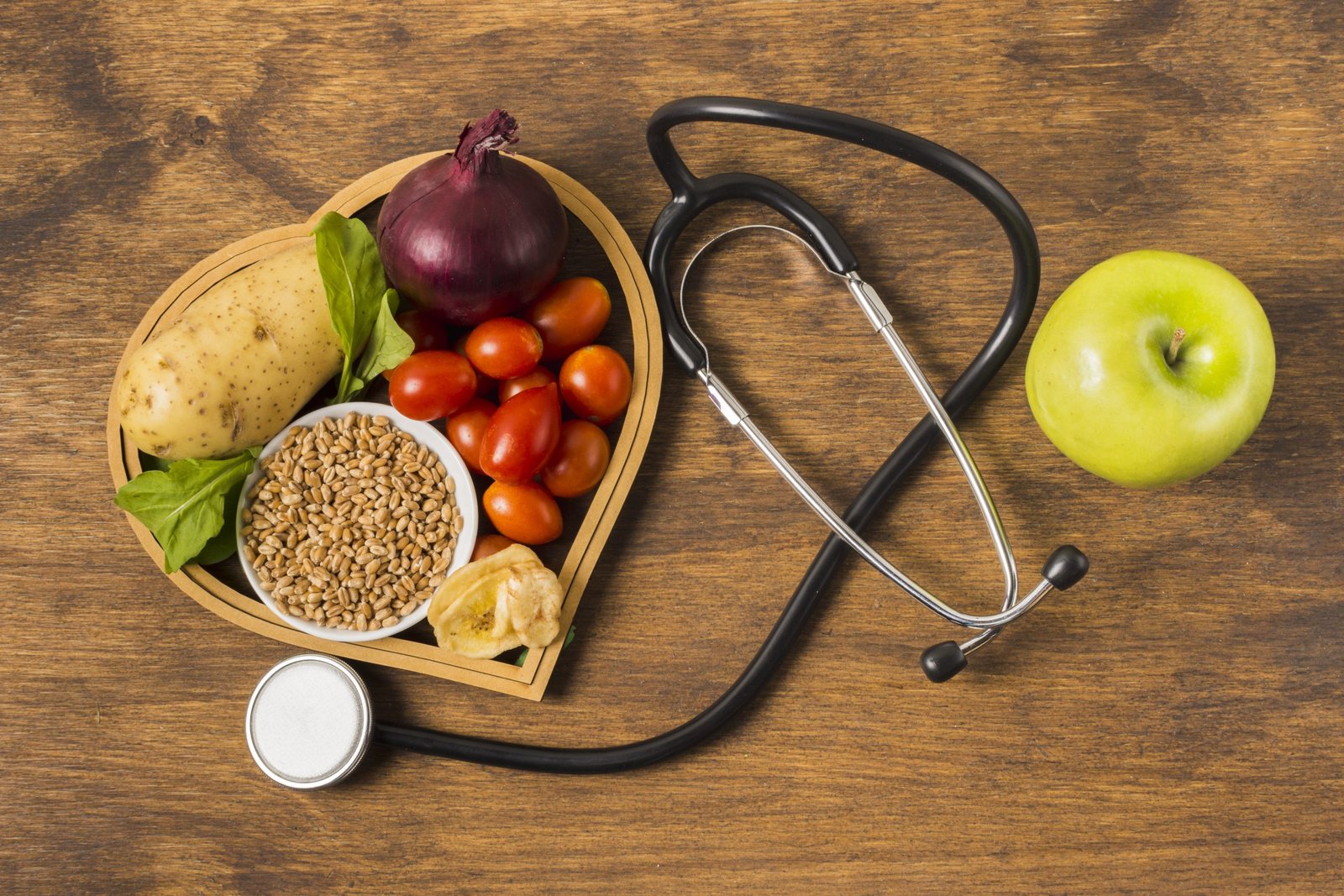
Definition of Nutritional Status:
Nutritional status is the condition of health of the individual as influenced by the utilization of the nutrients. It can be determined only by the correlation of information obtained through a careful medical and dietary history, a thorough physical examination and appropriate laboratory investigations.
(Ref: Robinson’s Normal and Therapeutic Nutrition/14th/6)
[OTHER DEFINITION – NICE TO KNOW]
Nutritional status is the condition of the health of the individual as influenced by the utilization of the nutrients. It is determined by taking medical history, physical examination and laboratory investigation.
(Ref: Onila Salin’s Essential nutrition/1st/3)
Assessment Methods of Nutritional Status:
Direct Methods of Nutritional Assessment
These are summarized as ABCD
- Anthropometric methods
- Biochemical, laboratory methods
- Clinical examination methods
- Dietary evaluation methods
Indirect Methods of Nutritional Assessment
- These include three categories:Ecological variables / factors.
- Economic factors e.g. per capita income, population density & social habits
- Vital health statistics particularly infant & under 5 mortality & fertility index
Direct Methods of Nutritional Assessment
A. Anthropometric methods/Nutritional Anthropometry:
a) Height & weight
- Gomez classification (height for age)
- Well come classification (weight for age)
- Waterlow’s classification (weight for Height)
b) Arm circumference
c) Skin fold thickness, ami lanabiston was zadk
B. Biochemical evaluation:
a) Laboratory tests: Hemoglobin (Hb) estimation, stool examination, Urine examination,
b) Biochemical tests: Serum iron, Serum retinol, Urinary iodine, Serum folate.
C. Clinical examination:
A WHO Export Committee classified signs used in nutritional surveys into 3 categories as those:
a) Not related to nutrition: e.g. alopecia, pyorrhoea, pterygium
b) That needs further investigation: e.g. malar pigmentation, corneal vascularization,
geographic tongue.
c) Known to be of value: e.g. angular stomatitis, Bitot’s spots & enlargement of thyroid gland etc.
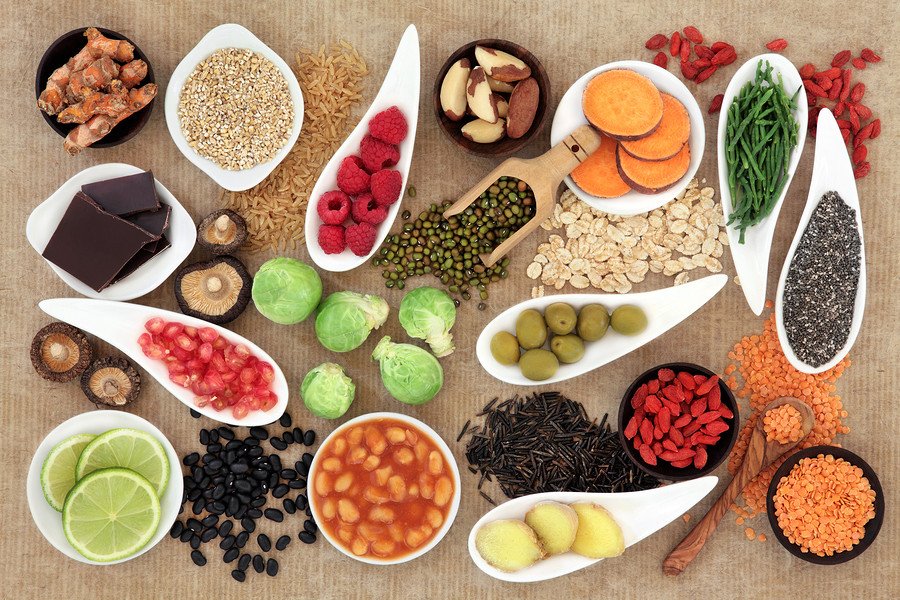
D. Dietary survey/ Assessment of dietary intake:
A diet survey may be carried out by one of the following methods:
a) Weighment of raw foods
b) Weighment of cooked foods.
c) Oral questionnaire method.
Indirect Methods of Nutritional Assessment
A. Vital & Health statistics:
a) Infant mortality rate
b) Neonatal mortality rate
e) Still birth rate, etc.
B. Ecological studies:
a) Food balance sheet e.g. per capita supply
b) Socio-economic factors e.g. family size
c) Health and educational services e.g. PHC service
d) Conditioning influences e.g. viral infection.
Others
Functional Assessment:
a) Structural integrity,
b) Host defense,
e) Hemostasis,
d) Reproduction,
e) Nerve function,
f) Work capacity.
Signs of Nutritional Imbalance:
| SL | Area of concern | Possible deficiency | Possible excess |
| 1 | Hair:
|
|
|
| 2 | Head and neck
|
|
|
| 3 | Eyes
|
| |
| 4 | Skin
|
|
|
| 5 | Nails
|
| |
| 6 | Mouth
|
| |
| 7 | Abdomen:
|
|
|
| 8 | Heart:
|
|
|
| 9 | Neurologic
|
|
|
| 10 | Musculoskeletal, extremities:
|
|
|
Poor Clinical Signs of Nutritional Status:
1. General appearance: Restless, apathetic, cachexic.
2. Hair: Stringy, dull brittle, de-pigmented.
3. Neck glands: Thyroid enlarged.
4. Skin, face, neck: Greasy, discolored, scaly.
5. Eyes: Dryness, signs of infection, increased vascularity, glassiness, thickened Conjunctivae
6. Lips: Dry, scaly, swollen, angular lesions (stomatitis)
7. Tongue: Papillary atrophy, smooth appearance, swollen, red, beefy (glossitis)
8. Gums: Marginal redness or swelling, receding, spongy.
9. Teeth: Unfilled cavities, absent teeth, worn surface, mottled, mal-positioned.
10. Skin, general: Rough, dry, scaly, pale, pigmented, irritated.
11. Abdomen: Swollen.
12. Legs, feet: Edema, tender caft, tingling, weakness.
13. Skeleton: Bowlegs, knock-knee, chest deformity at diaphragm, beaded ribs, prominent scapula’s.
14. Weight: Overweight or underweight.
15. Muscles: Flaccid, poor tone, undeveloped, tender.
16. Nervous control: Inattentive, irritable.
17. Gastrointestinal function: Anorexia, indigestion, constipation or airhead.
18. General vitality: Easily fatigued, no energy, falls asleep in school, looks tired, apathetic.
(Ref: June D Thompson/24/773-774)

Signs of Good Nutritional Status:
1. General appearance: Alert, responsive.
2. Hair: Shiny, lustrous, healthy scalp,
3. Neck glands: No enlargement.
4. Skin, face, neck: Smooth, slightly moist, good color, reddish pink mucous membranes,
5. Eyes: Bright, clear, no fatigue circles.
6. Lips: Good color, moist.
7. Tongue: Good pink color, surface papillae present, no lesions.
8. Gums: Good pink color, no swelling or bleeding firm.
9. Teeth: Straight, no crowding, well-shaped jaw, clean, no discoloration.
10. Skin, general: Smooth, slightly moist, good color.
11. Abdomen: Flat.
12. Legs, feet: No tenderness, weakness, swelling, good color.
13. Skeleton: No malformation.
14. Weight: Normal for height, age, body builds.
15. Muscles: Well-developed, firm.
16. Nervous control: Good attention span for age, does not cry easily, not irritable or restless.
17. Gastrointestinal function: Good appetite and digestion, normal, regular elimination.
18. General vitality: Endurance, energetic, sleeps well at night, vigorous.
(Ref: June D Thompson/2nd/773-774)
Measurement of Nutritional Anthropometry:
A. Measuring Weight and Height: Formula for approximate average weight and height of t normal infants and children
| Weight: | Height: |
|
|
|
|
|
|
|
B. Measuring Occupito -Frontal Circumference (OFC): It is generally measured in infants and children less than 3 years of age by a flexible, non-stretchable measuring tape.
Procedure of measurement:
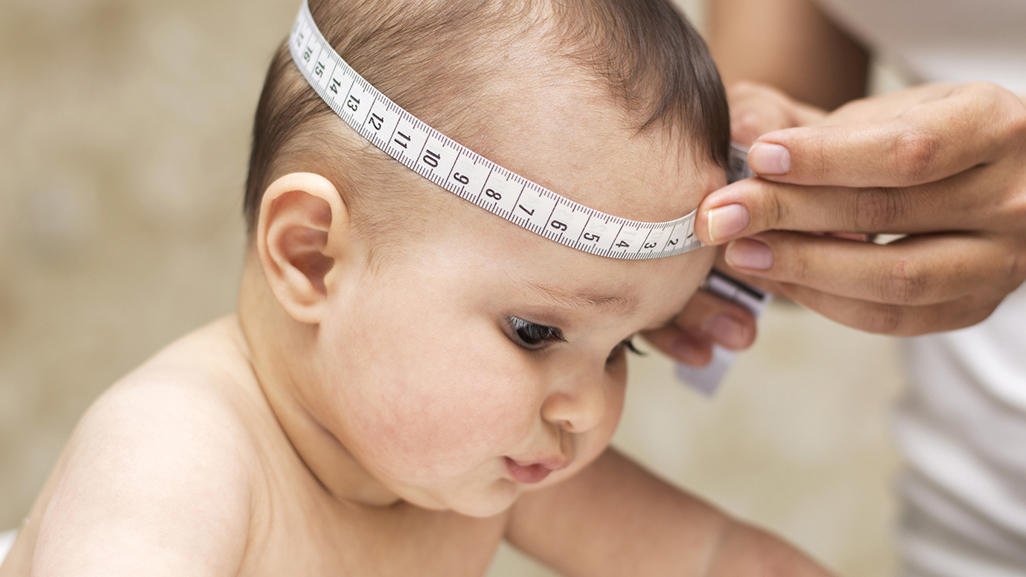
Average OFC of a child:
| At 3 months (cm) | At 6 months (cm) | At 1 year (cm) | At 1 year (cm) |
| 41 | 44 | 47 | 49 |
C. Measuring the MUAC of children: A special tape is used for measuring the MUAC of a child (see Figure 2.3). The tape has three colours, with the red indicating severe acute malnutrition, the yellow indicating moderate acute malnutrition and the green indicating normal nutritional status. Figure 2.4 shows you how to use the tape to measure a child’s MUAC.
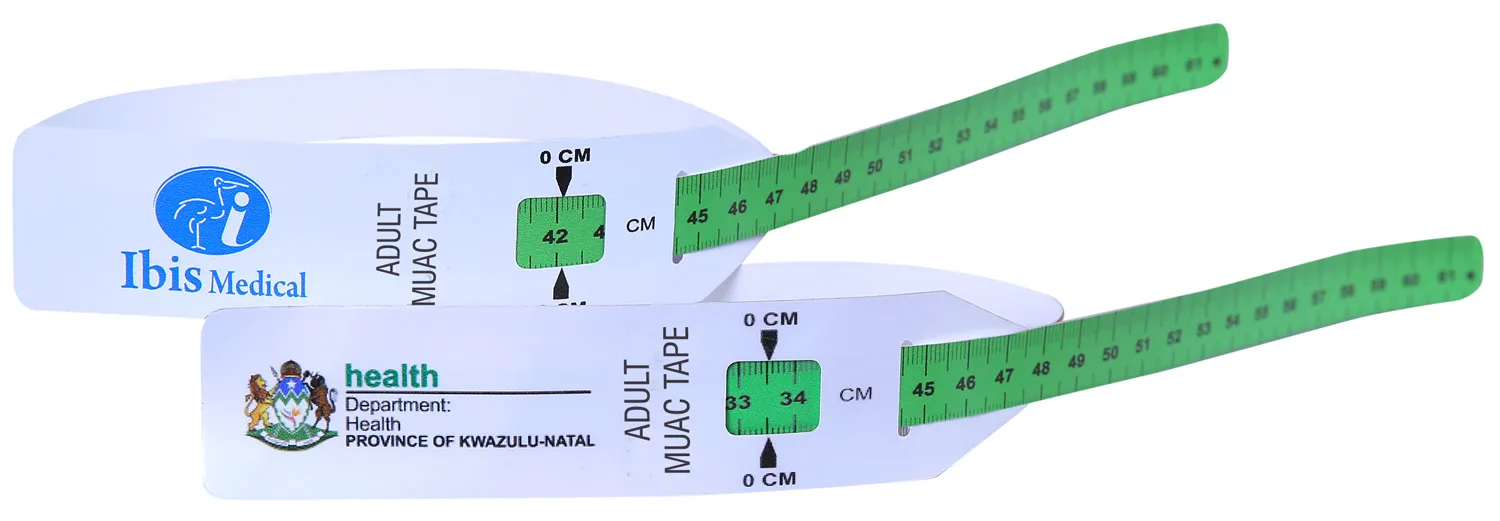
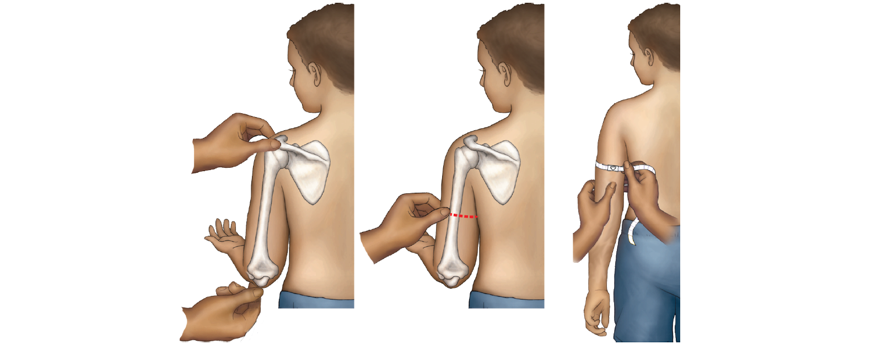
Procedures for measuring MUAC
- Ask the mother to remove any clothing that may cover the child’s left arm. If possible, the child should stand erect and sideways to the measurer.
- Estimate the midpoint of the left upper arm (arrow 6).
- Straighten the child’s arm and wrap the tape around the arm at the midpoint. Make sure the numbers are right side up. Make sure the tape is flat around the skin (arrow 7).
- Inspect the tension of the tape on the child’s arm. Make sure the tape has the proper tension (arrow 7) and is not too tight or too loose (arrows 8 and 9). Repeat any step as necessary.
- When the tape is in the correct position on the arm with correct tension, read the measurement to the nearest 0.1 cm (arrow 10).
- Immediately record the measurement.
| Level of nutrition | MUAC |
| Normal | >13.5 cm (green) |
| Borderline PEM. | 12.5-13.5 cm (yellow) |
| Malnourished. | <12.5 cm (red) |
D. BMI (Body Mass Index):
The body mass index (BMI) or Quetelet index is a value derived from the mass (weight) and height of an individual. The BMI is defined as the body mass divided by the square of the body height, and is universally expressed in units of kg/m², resulting from mass in kilograms and height in meters.

Formula:
| Metric BMI Formula | Imperial BMI Formula |
| BMI = weight (kg) + height (m²) | BMI = weight (lb) + height² (in³) × 703 |
Example Using Formula
For an adult with height of 180 cm and weight of 75 kg. Our first step needs to be to convert the height into meters (British spelling: metres). As there are 100cm in a meter, we divide our figure by 100. This gives us 1.8m.
Let’s plug those figures into our formula:
BMI=75÷(1.8 × 1,8)
BMI=75÷3.24
This gives us a BMI figure of 23.15
Read more:
